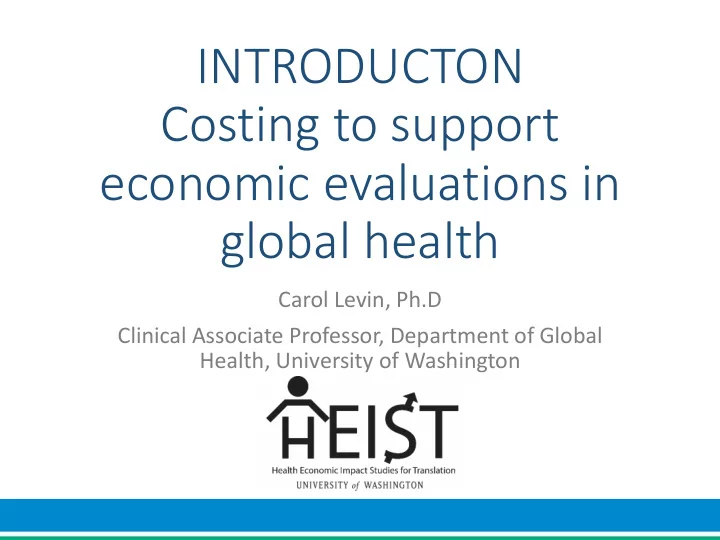

INTRODUCTON Costing to support economic evaluations in global health Carol Levin, Ph.D Clinical Associate Professor, Department of Global Health, University of Washington
Interest is high 2 10/1 3/16
Multiple uses for cost data Priority setting for new interventions or Resource requirements introducing new and advocacy technologies, drugs, vaccines Financial planning and Improving technical budgeting efficiency
What do we know? A lot as it turns out • Published systematic literature reviews on costs for • HIV • Immunization • TB • Cardiovascular disease • Nutrition • Disease Control Priorities Project • Global Health Cost Consortium • EPIC Immunization Costing community of practice 4
Disease Control Priority literature reviews • Searches for economic evaluations (costs, CEA) • RMNCH • Reproductive health and family planning • Maternal, Child and Neonatal health and nutrition • PMTCT • Non-communicable disease • CVD, diabetes, respiratory • Cancers (Breast, cervical, pediatric, liver, colon) • Mental Health • Essential Surgery • HIV, TB, Malaria, • Injury Prevention
DCP systematic reviews: Inclusion criteria • Type of evaluation • Partial economic evaluation • Includes only costing data • Full economic evaluation: • Includes both costs and effectiveness • Only keep if it has good cost data • Measurement/Study Type • Must have either or both: • Unit costs • Cost of intervention • Includes direct costs, or both direct and direct non- medical • Focus on costs of implementing the interventions • Treatment costs • Only English articles
Increase in number of studies over time Reproductive, Cardiovascular and maternal, neonatal and respiratory cost child health studies 30" Sub/Saharan"Africa" 25" South"Asia" 20" Mul=ple" Middle"East"and"Northern" 15" Africa" La=n"America"and" Carribean" 10" Europe"and"Central"Asia" Eastern"Asia"and"Pacific" 5" 0" 2000" 2001" 2002" 2003" 2004" 2005" 2006" 2007" 2008" 2009" 2010" 2011" 2012" 2013" 2014" ! Growing body of literature in low and middle income countries
So what’s the problem? Depends on your perspective • Donor “Do we need more cost studies?” • Can’t we use the data we have? • Researchers “We need better data” • Understand costs alongside clinical trials and demonstration projects to improve service delivery for wide range of conditions and diseases • Health Economists are moving toward more expensive studies Larger samples sizes to improve precision, accuracy and • robustness. • Decision makers “We need information today” • WHO “Let’s build a sustainable system for routine cost collection.” 8 10/1 3/16
Challenges • Program costs are inadequate and of mixed quality • Costs are not locally relevant, are not quality adjusted, or are available from a limited perspective (e.g. the payers) • Costs don’t capture full system costs and fail to capture variations in cost by delivery strategy/platform. • No valid methods for projecting costs from one setting to others. • Lack of standard methods or standard reporting for costing studies • Multiplicity of ways to estimate costs • Little attention by authors to quality check lists for costs, although they do exist. • Limited packages of interventions estimated using costing tools
Economic c Evaluation in Global Perspect ctive: A Bibliometric c Analysis of the Rece cent Literature Source: Pitt, C., Goodman, C. and Hanson, K., 2016. Economic evaluation in global perspective: A bibliometric analysis of the recent literature. Health economics, 25(S1), pp.9-28. Health Economics pages 9-28, 25 JAN 2016 DOI: 10.1002/hec.3305 http://onlinelibrary.wiley.com/doi/10.1002/hec.3305/full#hec3305-fig-0001
Limited availability of ART cost data
Limited availability of condom cost data
Variability in costs: example: Reproductive and maternal health Reproduc)ve+and+Maternal+Health+Costs+in+Low8+and+Middle8 Income+Countries+(USD+2012)+ Average!Abor.on!(per!event)! D&C!Abor.on!(per!event)! Medical!Abor.on!(per!event)! MVA!Abor.on!(per!event)! Post?Abor.on!Care!(per!event)! Cesarean!Sec.on!(per!delivery)! Vaginal!Delivery!(per!delivery)! Delivery!Complica.ons!(per!delivery)! Family!Planning!(per!year!of!protec.on)! !$0!! !$1!! !$10!! !$100!! !$1,000!! !$10,000!! Median!Cost! Minimum!–!Maximum!Cost! 13 10/1 3/16
Lack of cost data for low capacity settings: RMNCH cost data for Ethiopia 14 10/1 3/16
Efficient micro-costing: Challenge / Opportunity
Why does it matter? Consequences • Are new health technologies and innovative service delivery interventions good value for money? Are they cost-effective? • Countries and donors often do not know the correct cost estimates to use in financial planning, resource allocation and budgeting. • resources are misallocated and health benefits are foregone. • Over time, efficiency improvements cannot be measured. • Donors, funders and National Finance Ministries cannot assess whether they are getting value for their money, and cannot provide effective incentives for greater efficiency.
Actions to improve costing • Development of a cost reference case for economic evaluation in low-resource settings • Reference case for cost-effectiveness already exists • Global health costing consortium is generating improved costs for HIV and TB • New Gates funded project on immunization financing is generating improved estimates for vaccines • At UW, HEIST! So let’s get busy. What are we waiting for? 17 10/1 3/16
Recommend
More recommend